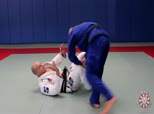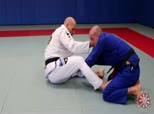Inside the University 7.1 - Options to Break Posture from Closed Guard
Add to Favorites Remove From Favorites 1315 4145 days ago
Xande reviews various ways to break your opponent's posture from the closed guard. In this series we notice that there are two basic variations, one variation where we break our opponent's posture forward by using our legs and gripping at the elbow or coming in from under your opponent's hand to break their base and another variation where we redirect our opponent's arm to the side in an arm drag style posture break.
Inside the University 6.1 - Black Belt Session Butterfly and Open Guard Concepts and Control Part 1/2
Add to Favorites 1465 Remove From Favorites 4146 days ago
Xande explains his competition mindset and talks at length about how it's important to be able to threaten your opponent at all times with both submissions and sweeps. He talks about how positioning yourself safely and taking your opponent's balance is the jab that will open up opportunities for successful sweeps and submissions. Xande also demonstrates some butterfly and open guard concepts such as how to engage your opponent in the butterfly when your opponent is trying to stay distant as well as how to maintain your butterfly guard when your opponent attempts the knee cross pass and the side smash pass.Inside the University 6.2 - Black Belt Session Open Guard Concepts and Control Part 2/2
Add to Favorites 1081 Remove From Favorites 4146 days ago
Xande demonstrates his open guard retention and control as well as how he mixes up his sweeps and submission attempts to flow together from one to the next.JJU 17-14 Two Handed Torreada Pass Defense
Add to Favorites 1425 Remove From Favorites 4148 days ago
Sometimes your opponent will initiate the torreada pass looking to get around your legs just enough to drop his hips onto your body to immobilize you to finish the pass. In this case, your hands must frame against your opponent's body before their hips are able to apply pressure. Using your frame, immediately shrimp away from your opponent to clear enough room to get your legs between you and your opponent to recover the guard. The pass defense must be built into reflex to achieve an instant response to stop your opponent's pass attempt as every second that you give to them increases their opportunity to pass.JJU 25-13 Double Underhook Hop Pass Variation
Add to Favorites 806 Remove From Favorites 4149 days ago
This Double Underhook Pass is quick and works well when your opponent is spending a lot of his energy to keep his legs open and driving down in an attempt to prevent your more classical double under pass by stacking. Instead of muscling your opponent's legs, hop over their legs instead to secure the side control.Inside the University 5 - One Handed Y Grip Break
Add to Favorites 814 Remove From Favorites 4150 days ago
Xande's Y Grip Break is one of the rare techniques that can be picked up almost immediately just by watching. Instantly put this one handed sleeve grip break into your game to help free your arm when passing your opponent's guard or when you are fighting for grips.Inside the University 4 - Framing Concepts in Action to Create Space and Mobility
Add to Favorites 2068 Remove From Favorites 4151 days ago
Xande talks about how his guard has only been passed by two people in two decades of jiu jitsu competition and how being able to frame and always stay safe will allow you to build up to an impassable guard. In this lesson we learn how to set the frame and use it to create the space and mobility needed to recover your guard. We learn that after setting the frame and/or shield on our opponent, we can greatly increase our mobility by using our other arm to frame against the ground with our elbow or hand for maximum mobility.Inside the University 4.1 - Managing Safe Distance and Difference Between Sport and Self Defense BJJ
Add to Favorites 858 Remove From Favorites 4151 days ago
Xande talks about his competition mindset and how his fighting strategy is the same regardless of whether the fight is scored with points or with submission only. Being able to sprinkle in submission attempts with your sweep attempts and always threatening with attacks will make for a more dangerous guard because it will be easier to keep your opponent guessing. He also talks about how managing a "safe distance" can be mean different things depending on whether we're fighting a sport bjj match or a MMA fight with punches.JJU 17-11 Collar Drag When Opponent Sits Back
Add to Favorites 1007 Remove From Favorites 4152 days ago
This lesson was not in the JJU book but shares the same concept of collar dragging your opponent except from a different situation. In this situation, your opponent is on their knees and leaning their weight back in an attempt to prevent the collar drag. Some minor adjustments allow us to create the opportunity to collar drag our opponent even though they are on their knees and assuming a stalling position. The collar drag from butterfly goes very well in combination with the ankle pick from butterfly. This combination echoes the action-reaction concept that can be seen in many transitions in jiu jitsu.JJU 17-12 Ankle Pick Against Torreada Pass
Add to Favorites 1121 Remove From Favorites 4153 days ago
The ankle pick from the guard is a quick way to score two points and is very useful in combination with the collar drag from butterfly guard. As you attempt a collar drag, your opponent may draw his weight back, setting you up for the perfect opportunity to sweep and come on top with the ankle pick instead. This combination clearly echoes the action-reaction concept that can be found in many other transitions in jiu jitsu.JJU 25-21 to 25-22 Closed Guard Break with Knee Up the Middle and Opening Against Double Underhooks
Add to Favorites 803 Remove From Favorites 4155 days ago
In this lesson we learn two ways to open your opponent's closed guard. The Knee up the Middle guard break uses your knee as a wedge to create space to force open the legs. It's a simple but highly effective solution for forcing open the closed guard against opponents with longer legs. We also learn how to deal with opening the closed guard when your opponent is hugging on to you like an overly-cuddly sloth or koala bear with the double underhooks.Inside the University 3 - Setting Up Takedown Combinations
Add to Favorites 938 Remove From Favorites 4156 days ago
Saulo explains how to set up successful takedowns. He talks about the importance of having shorter and more explosive movements in our takedown attempts, using one or multiple takedowns as a decoy to set up the next.











